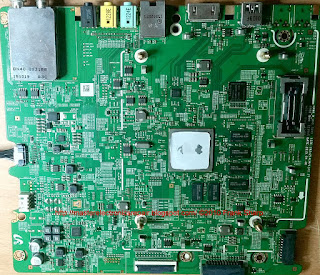
Technical description and composition of the SAMSUNG UE75JU7000U TV, panel type and applicable modules. The composition of the modules.
SAMSUNG LED
Model: UE75JU7000U
Chassis / Version: BN41-02356
Panel: CY-GJ075FLLV3V
LED backlight: Edge LED
T-CON: UD120_EU22ATLTSTG2_V0.2
LED driver (backlight): integrated into PSU
Power Supply (PSU): BN44-00813A L78S7N_FSM REV 1.2
MainBoard: BN41-02356C & BN41-02417A (Scaler)
IC MainBoard: CPU: SDP1406, SPI FLASH: Winbond 25Q40, EEPROM: 24C512
Tuner: BN40-00318B
Technical Specifications UE75JU7000U
SAMSUNG UE75JU7000U
General repair guidelines for TV LCD LED
Possible manifestations of defects
- SAMSUNG UE75JU7000U does not turn on and does not show any signs of performance at all. Does not blink indicators and does not respond to control buttons.
Failure in such cases should begin to be sought in the power supply circuits BN44-00813A. It is then necessary to measure its output voltages and, if they are absent, it is necessary to check the power switches and rectifier diodes of the converters for a short-circuit probability.
In case of diode breakdowns in the secondary circuits, the converter can operate in emergency short-circuit mode without output voltages, and during short circuit in the power elements of the primary circuit, the mains fuse and / or current sensor at the source of the key usually breaks.
Mos-Fet power switches, used in switching power supplies, sometimes fail due to a malfunction of any other elements that can put it out of operation in key mode, or create an excess of the maximum permissible parameters of the switch. These can be elements supplying the PWM controller, frequency-setting or damping circuits, or negative feedback elements in the stabilization circuit. PWM controllers, in the absence of visible damage or frank short-circuit between the terminals, are checked by replacing with new, or obviously working.
- There is no image, there is sound, it responds to the remote control, the channels are switched. In some cases, the image appears when you turn on and immediately disappears.
As a rule, in such cases there is no display backlight. The reason can be both in the power supply of the LEDs, in their serviceability (breakdown or breakage), as well as in the violation of the contact connections of the LED strips.
To check the LED strips, to open all the transitions of the LEDs, several tens of volts or more are needed, it is best to use a current source for such purposes. The breakage of several PN junctions connected in series cannot be detected with a multimeter or tester. In such cases, it is necessary to open the panel and check each LED. If your multimeter cannot open the LED transitions in forward bias, sometimes you can detect the presence of a PN junction of the protective zener diode by connecting the probes in the opposite direction. If the zener diode is broken or broken in short-circuit, then the LED is faulty and needs to be replaced.
- The TV does not turn on, the indicator indicates standby or operating mode, or blinks.
Repair or diagnostics of the BN41-02356C motherboard should begin by checking the stabilizers and power converters needed to power the chips and matrix. If necessary, update or replace the software (software). If it is not possible to replace the MB (SSB) card, you need to check the health of its elements - CPU: SDP1406, SPI FLASH: Winbond 25Q40, EEPROM: 24C512. Defective components should be replaced.
In the absence of tuning to the channels of on-air or cable television, you should make sure that the software is correct, as well as in accordance with the ratings of the supply voltage at the terminals of the tuner BN40-00318B. It is also necessary to check the presence of pulses of data exchange between the tuner and the processor via the I2C bus using an oscilloscope.
Attention TV owners! Attempts to self-repair SAMSUNG UE75JU7000U are not recommended by the manufacturer and can lead to serious negative consequences!
 The appearance of the MainBoard BN41-02356C is shown in the figure below:
The appearance of the MainBoard BN41-02356C is shown in the figure below:BN41-02356C
The appearance of the power supply
Main features of the SAMSUNG UE75JU7000U device:
Installed matrix (LED panel) CY-GJ075FLLV3V.
The matrix control uses the Timing Controller (T-CON) UD120_EU22ATLTSTG2_V0.2.
To power the backlight LEDs, a converter is used, combined with a power supply.
The formation of the necessary supply voltages for all nodes of the SAMSUNG UE75JU7000U TV is carried out by the BN44-00813A power module, or its analogues.
MainBoard - the main board (motherboard) is a BN41-02356C module, using CPU chips: SDP1406, SPI FLASH: Winbond 25Q40, EEPROM: 24C512 and others.
The tuner BN40-00318B provides the reception of television programs and tuning to channels.

